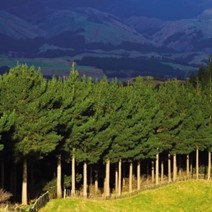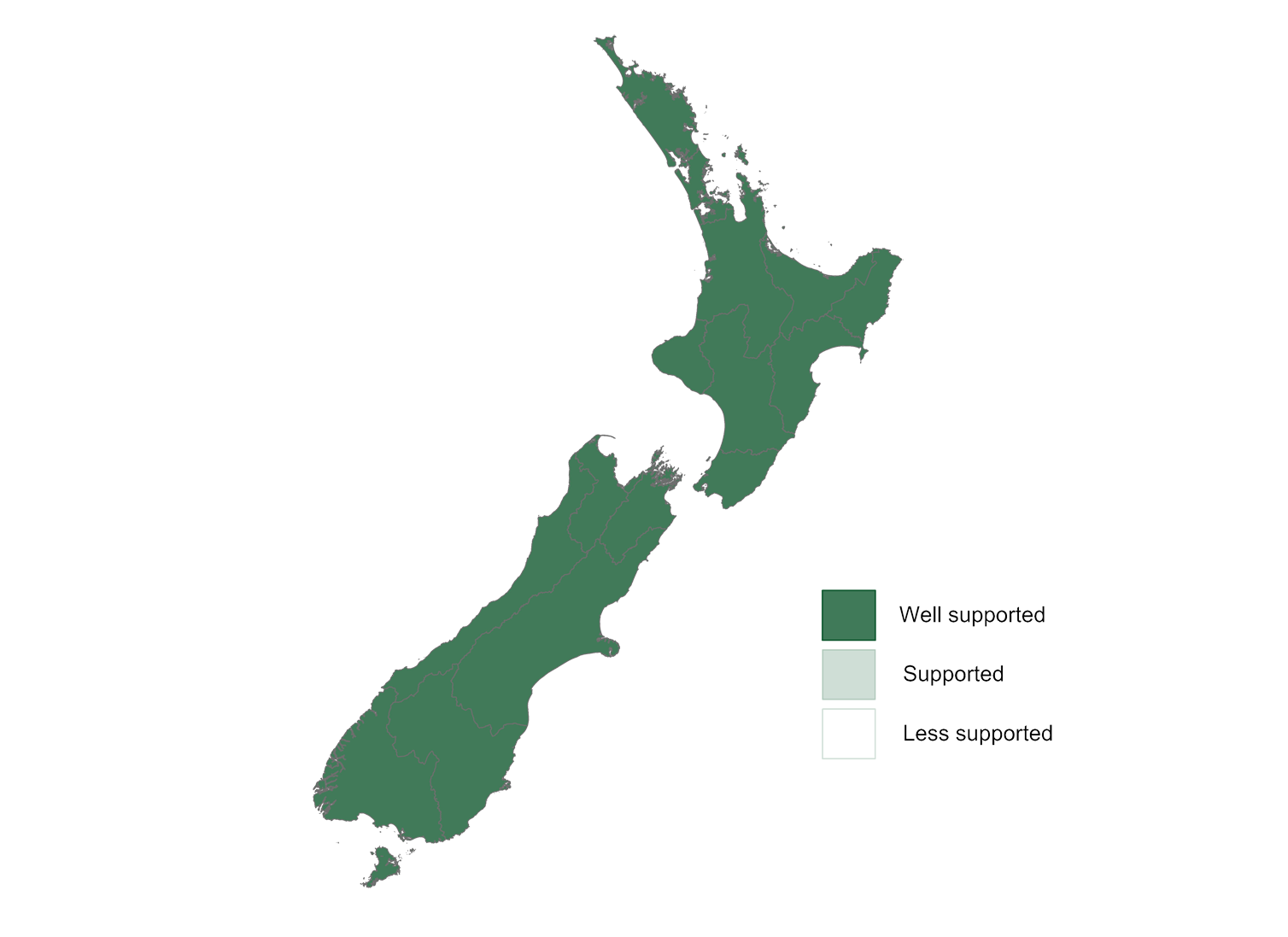
Land use fact sheet
Forestry: Introduction to plantation forestry
There are many reasons to plant trees on your whenua, including commercial harvesting, ecological restoration and protecting waterways. This fact sheet focuses on plantation forestry with the end goal of harvesting timber and carbon credits for a profit.
The forestry industry is well-established in New Zealand. There's nearly 200,000ha of plantation trees on Māori freehold land alone.
Forestry is a critical part of our journey to a low-emissions economy, so there is a huge amount of advice, support and resources available to anyone thinking about forestry, managing a forestry block, or getting ready to harvest.
 Overview
Overview
Regions
Forestry can be grown in all regions of New Zealand. There are many different exotic and native species to choose from.
Growing conditions
Plantation forestry is suited to most land types up to LUC 7. It is especially popular for classification 4 and above.
Climate
There are many available tree species with a variety of climate preferences. Research your options before choosing.
Commercial scale
A 5ha block can be profitable if it is not too remote, is carefully managed, has a good crop and access for heavy machinery.
Getting started
Make sure you check with your local council for available funding, as well as Te Uru Rākau’s funding options.
Skills / employment
Many of NZ’s 9,000-plus forestry workers are part of contractor gangs who carry out planting, thinning, pruning and harvesting.
 Regions
Regions
Forestry is established in all regions of New Zealand.
Get a report on your whenua
Enter the details of your whenua into our search to create a downloadable report showing information about the environment, economy, and climate in your region — and the potential that creates for development.

 Commercial scale
Commercial scale
5ha of easily-accessible land close to infrastructure.
You may be able to lease blocks of 40 ha or more to a forestry company to develop. Smaller blocks may be able to collaborate with neighbours to reach commercial scale for leasing.
Commercial scale is affected by accessibility. Forestry is one of the few commercial options available to land that can't be converted to cropping or profitable farming easily, so it often appears in small blocks, and in areas of larger blocks that have fewer options because of the terrain or soil properties.
However, timber plantations need good access for heavy machinery. Small sites with poor access can be uneconomical to harvest, depending on the value of the timber species being considered. These sites may be better suited to planting a permanent block, with the option of carbon farming or mānuka for honey production.
 Getting into the industry
Getting into the industry
New Zealand has more than 1.7 million hectares in plantation forestry. It's an established and critical component of our economy, and key to whether or not we achieve our international obligations to reduce carbon emissions.
Planting forestry on your block involves a significant financial investment and a 15-60 year time commitment depending on the species.
Planning
The Canopy website provides resources to support you throughout your forest project and to help you make decisions at each stage.
Leasing
You may be able to lease blocks of 40 ha or more to a forestry company to develop. Smaller blocks may be able to collaborate with neighbours to reach commercial scale for leasing.
Forestry leases are long term, with most common rotations ranging from 15-30 years depending on species. It's important to get advice from qualified, experienced advisors before you commit to leasing your whenua.
Right tree, right place, right purpose
The right tree, in the right place, for the right purpose is a vision statement that encourages growers to choose a species that is suitable for the site and the intended use.
There is a huge variety of exotic and native timber tree species and a broad range of climates, soils and terrains across the motu. There is also a wide variety of markets and end uses for our timber products.
These questions can help you decide what type of trees are right for your whenua.
- Which species are suited to your block’s climate, soil and terrain? Both exotic and native species can be planted for timber. Be careful to check the sustainable forestry requirements for native plantations.
- Where will you plant? Does the block’s size and accessibility mean that it will be profitable to harvest for timber, or would it be better suited to planting a permanent block for carbon farming?
- What market will you target? For example, radiata pine can achieve one price as structural timber or a higher price as clearwood timber. Growing structural timber requires less hands-on management than clearwood. A pruned/clearwood regime requires a well-managed silviculture regime during the growth period including more investment in thinning and pruning.
What to think about when planting forests
Indigenous (native) timber forestry
Around a third of native forestry that is growing outside conservation land is suitable for timber, as long as sustainable harvesting rules are followed.
Te Uru Rākau native (indigenous) forestry
Access to funding
There are many funds and grants available to help you plant trees on your whenua. Your local regional and district council will have grants available to support some types of planting, such as memorials, restoring biodiversity, protecting waterways or preventing erosion.
Contact them directly to find out what support they can offer.
Find contact details for your local or regional council
Search for funding opportunities
Forestry and carbon
Forestry actively removes greenhouse gases from the atmosphere, so it is a critical pathway to New Zealand’s transition to a low emissions economy and to achieve net zero carbon.
Summary: Climate Change Response (Zero Carbon) Amendment Act 2019
New Zealand has an Emissions Trading Scheme (ETS) that aims to:
- encourage people and businesses to reduce the emission of greenhouse gases, by placing a cost on their production
- encourage people to increase the number of trees planted, by providing an additional income stream.
You can collect carbon credits while your plantation is growing. These can be sold to generate an income. A proportion of these credits will need to be paid back when the plantation is harvested so be careful to keep track of these obligations.
Introduction to the Emissions Trading Scheme (ETS) for forestry
Deforestation
Deforestation is the act of removing forestry from your land. If you choose not to replant your block after felling the trees for timber harvest or other reasons, you may face costs under the ETS.
Seek advice
It's important to get experienced, qualified advice when making decisions about forestry on your whenua. The advisory industry is not regulated, so seek recommendations from others who have been through the process in the past.
Alternatively, the New Zealand Institute of Forestry (NZIF) is an industry organisation that represents New Zealand’s forestry professionals. They maintain a publicly available register of consultants who meet their standards for registration.
 Skills and employment
Skills and employment
Plantation forestry covers around 1.7M hectares of land in New Zealand. It provides permanent and seasonal employment for more than 9,500 people each year.
Smaller land blocks usually use contracting gangs for silviculture such as:
- site preparation
- planting
- thinning
- pruning, and
- harvesting activities.
It is important to use experienced operators, as the quality of the silviculture has a direct impact on the quality of the end product and the price you can expect for your timber.
 Compliance
Compliance
National environmental standards for plantation forestry (NES-PF)
The NES-PF were launched in May 2018 to standardise forestry-related environmental regulations across regional council boundaries, which previously had different rules.
National environmental standards for plantation forestry (NES-PF)
Your council will need to be notified about some forestry activities, such as harvesting or planting new forestry areas. You may also need consent for clearing existing trees or other vegetation before planting.
Seek qualified, experienced advice to ensure that you are aware of your obligations under the NES-PF.
Other regulations
Other regulations apply to activities including planting near waterways or services, harvesting, silviculture activities and transporting logs.
Always check with both your district council and regional council to find out if there are any restrictions or conditions on growing or harvesting trees in your area.
It's important to get qualified, experienced advice in order to understand your obligations. The Forest Practice Guides produced by the New Zealand Farm Forestry Association are also a useful resource.
If your block was in forestry before 1990, or if you have opted in to the Emissions Trading Scheme (ETS), you will also need to comply with the Climate Change (Forestry Sector) Regulations 2008.
 Growing conditions
Growing conditions
There is almost certainly a native or exotic species to suit the soil type, terrain and climate for your block. Consider why you want to grow a forest, then choose species that will grow on your site and match what you want to achieve.
Guide sheets for exotic timbers
 Climate
Climate
New Zealand’s climate supports a wide variety of exotic and native timber species.
Many species of Australian eucalypts thrive in the warmth of the Far North and northern South Island. American conifers, like the Douglas Fir, will happily cope with a good dump of snow. Radiata pine will grow anywhere and putting them all to shame are our beautiful native taonga species.
 Water
Water
Different species have different water requirements. It is not economically feasible to irrigate a forestry block, so take water availability into account when choosing the forestry species that you will plant.
 Market
Market
New Zealand has more than 1.7 million hectares in plantation forestry. Around 90% of this is in radiata pine.
Forestry contributed close to $7 billion in export earnings to New Zealand’s economy in the year to June 2019. This was an increase of nearly 8% from the previous year.
Demand for locally produced sawn timber has been steady. This has been driven by the Christchurch rebuild and demand from residential building activity, especially in Auckland.
 Future industry
Future industry
Demand for logs is expected to increase over the long term, driven by an underlying increase in population worldwide as well as within New Zealand. 8 of our top 10 markets are in the rapidly-growing South East Asia zone, so we're well-positioned to take advantage of the increasing demand.
The industry also benefits from work carried out by Scion, the forestry sector Crown Research Institute (CRI).Their research is focused on a range of topics to improve the outcomes of the forestry sector for New Zealand, including developing new products that can create new markets for our industry.
Some of these products, such as fuels, adhesives and resins, can be extracted from materials that are currently waste products, such as bark chip and slash. These are currently unused or create a cost overhead for forestry operators. Scion is working on opening up these new diversified markets to make forestry in New Zealand more sustainable and more profitable.
 Operational costs
Operational costs
Your forestry block needs to have good access for heavy machinery and equipment. Building new roads is expensive, and it's important to take this into account when deciding whether to plant forestry on your land. Small blocks that don't have good access may be better suited to permanent planting, which can be used to collect carbon credits for sale.
Silviculture costs over the life of the trees will depend on the species you are growing and the silviculture plan that is followed. It is important to get qualified advice when you're preparing the budget and forecast for your block.
 Grower returns
Grower returns
Forestry is a popular, well-established business in New Zealand, but many forest owners with relatively small blocks will only harvest their forests once or twice in their lifetimes. This makes it difficult to know how best to approach the process of harvesting and selling in order to get the best return.
It is important to seek qualified, experienced advice before engaging a contractor.
Small-scale grower harvest costs and returns
Estimating yield
Scion has developed an online forecaster calculator that estimates the amount of timber you can expect to get if you are harvesting pine or Douglas Fir trees. It is free to register and use the tool.
Seek advice before committing to a method of calculating payment for your timber. A range of options are available for calculating and structuring payments.
 Seek advice
Seek advice
Seek advice early, before you invest in any design or development.
Talk to your local Te Puni Kōkiri office to see how they can support you through your decision-making process. They will be able to provide advice and find out whether your project qualifies for funding.
If possible, seek out advice from people who grow plantation forestry in your area as well as knowledgeable suppliers.
Talk to qualified consultants who are experienced in plantation forestry and other land developments in your area. They will be able to provide detailed, impartial advice on what will (and won't) work on your whenua.
Check out Canopy, the website dedicated to helping you throughout your forestry journey.
 About this fact sheet
About this fact sheet
This fact sheet provides general information to help start and inform conversations. It is not comprehensive enough to support detailed decision-making.
The information in this fact sheet has been contributed by Te Uru Rākau, Scion, Farm Forestry New Zealand and Te Puni Kōkiri kaimahi. Data that has not been credited in the body of the fact sheet has been sourced from StatsNZ or provided by the contributors.
You can provide feedback on the content on this or any fact sheet by emailing the Whenua Māori Service at whenuainfo@tpk.govt.nz